The original Colorado Scale Model Solar System opened in 1987; in 2021, we updated it with a Voyage Mark II model. The original and new models show sizes and distances in our solar system at 1 ten-billionth actual size. The short (< 3 minute) video below shows excerpts from the opening ceremony.
Dedication
— Johannes Kepler (in a letter to Galileo), 1593
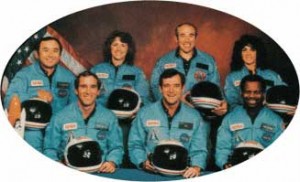 The original Colorado Scale Model Solar System was dedicated to the memory of seven astronauts who lost their lives when the Space Shuttle Challenger exploded 73 seconds after liftoff from the Kennedy Space Center in Florida on January 28, 1986:
The original Colorado Scale Model Solar System was dedicated to the memory of seven astronauts who lost their lives when the Space Shuttle Challenger exploded 73 seconds after liftoff from the Kennedy Space Center in Florida on January 28, 1986:
CU alumnus Ellison S. Onizuka B.S., M.S. (Aerospace Engineering, 1969)
Gregory B. Jarvis
S. Christa McAuliffe
Ronald E. McNair
Judith A. Resnik
Francis R. Scobee
Michael J. Smith
— Ada Lovelace (1815–1852)
The rebuilt (2021) Colorado Scale Model Solar System is dedicated to all the brave humans who have left the bounds of Earth, and especially to the seven astronauts who perished on the Space Shuttle Columbia in 2003:
CU Alumnus Kalpana Chawla M.S., 1986, PhD, 1988 (Aerospace Engineering)
Michael P. Anderson
David M. Brown
Laurel Clark
William C. McCool
Rick Husband
Ilan Ramon
Original Model (1987)
The original Colorado Scale Model Solar System was created by a team that consisted of my thesis advisor, Tom Ayres, three undergraduate students — Ken Center, Ron Bass, Matt Carter — and myself (Jeff Bennett). The idea for the model grew out of my experience teaching both at elementary and college levels, and it began to take shape when the three undergraduate students (all in my Honors astronomy course) volunteered to help make it happen, and Tom Ayres agreed to be the faculty lead for the project (I was a graduate student at the time). The team began work in 1984, but it was not until February 1986 that the team finally was able to seek formal permission to install the model on the university grounds. The Challenger accident had just occurred at that time (with CU alumnus Ellison Onizuka aboard), and physics professor Al Bartlett suggested that the model could become a memorial to the astronauts. The university President (Gordon Gee) and Chancellor (James Corbridge) agreed, and provided the funding that enabled us to create the black granite design (inspired by the Vietnam Memorial in Washington, DC). The model officially opened with a dedication ceremony on the day before commencement in May 1987. In 1993, the model was refurbished largely through the efforts of Tom Ayres, Jodi Schoemer, and Mike Verplanck. This refurbishment replaced the original color plaques for the Sun and the planet with bronze plaques, because the color ones had not held up well to the weather.
Read more about the original model and the motivations behind it in this article from Physics Today.
The photo below, taken from in front of the Fiske Planetarium, shows the inner solar system in the original Colorado model. The Sun was the gold sphere atop the pyramid. The black granite pedestal to the left of the Sun in the photo held Mercury, and the three pedestals visible to the right of the Sun held Venus, Earth, and Mars, respectively. All the inner planets are pinhead-size or smaller on this scale. The street beyond Mars, Regent Drive, corresponds roughly to the location of the asteroid belt. The outer planets, not visible in the photo, followed along the pathway that continues across the street. The map shows the original placement of the pedestals; note that the street crossing was later replaced with a pedestrian tunnel, and some of the pedestals moved at various times due to construction and landscaping changes. (Photo by Keith Gleason)
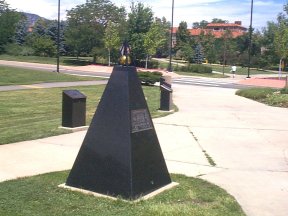
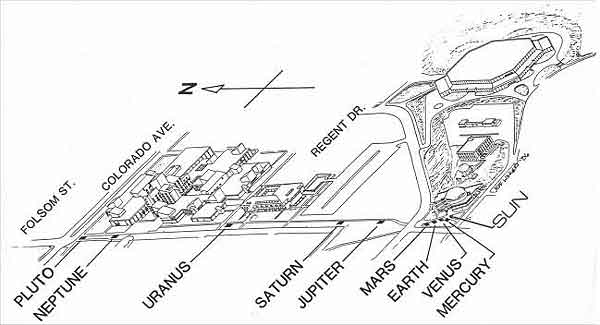
The CU Model Leads to Voyage in DC (2001)
The Colorado Scale Model Solar System provided the impetus for the Smithsonian Institution, the Challenger Center for Space Science Education, and NASA to create Voyage, a much more dramatic scale model solar system with color images and planets embedded in glass. (For details, see A Brief Voyage History on the Voyage page.) The first Voyage model opened on the National Mall in Washington, DC, on October 17, 2001. Voyage models have since spread to many other communities including Houston, Kansas City, Corpus Christi, Palo Alto, Memphis, and more. Click here to learn more about becoming a Voyage community.
2021 Update to the Colorado Scale Model Solar System
In 2019, then graduate student Jimmy Negus (Ph.D. 2023) came forward with the idea of updating and improving the by-then 32-year-old model (see this article). Jimmy formed a team along with faculty members Seth Hornstein and John Keller, and myself. We successfully raised the needed funds and secured backing from the campus administration to do this upgrade. The new model officially opened on Dec. 8, 2021, as the first installation of a “Voyage Mark II” model (from the Voyage National Program, as above). In this way, the model solar system program has come full circle, and more: The Colorado Scale Model Solar System led directly to the Voyage Scale Model Solar System, which brought the new “Mark II” model to Colorado — and which has already led to interest from dozens of other communities in spreading these models across the U.S. and around the world.
The new Voyage Mark II model is situated in the same general location and along the same pathway as the original model (aside from adjustments made for updated landscaping and building locations). We also retained the granite pyramid from the original model (but without the Sun at top, since there’s already a Sun in the Voyage Mark II), which houses the dedication plaques (see dedications above) along with general information about the Colorado model.
The photos below show the new inner solar system and the dedication ceremony (credit: Jodi Schoemer), and the map shows the locations of the stanchions in the updated CU model.
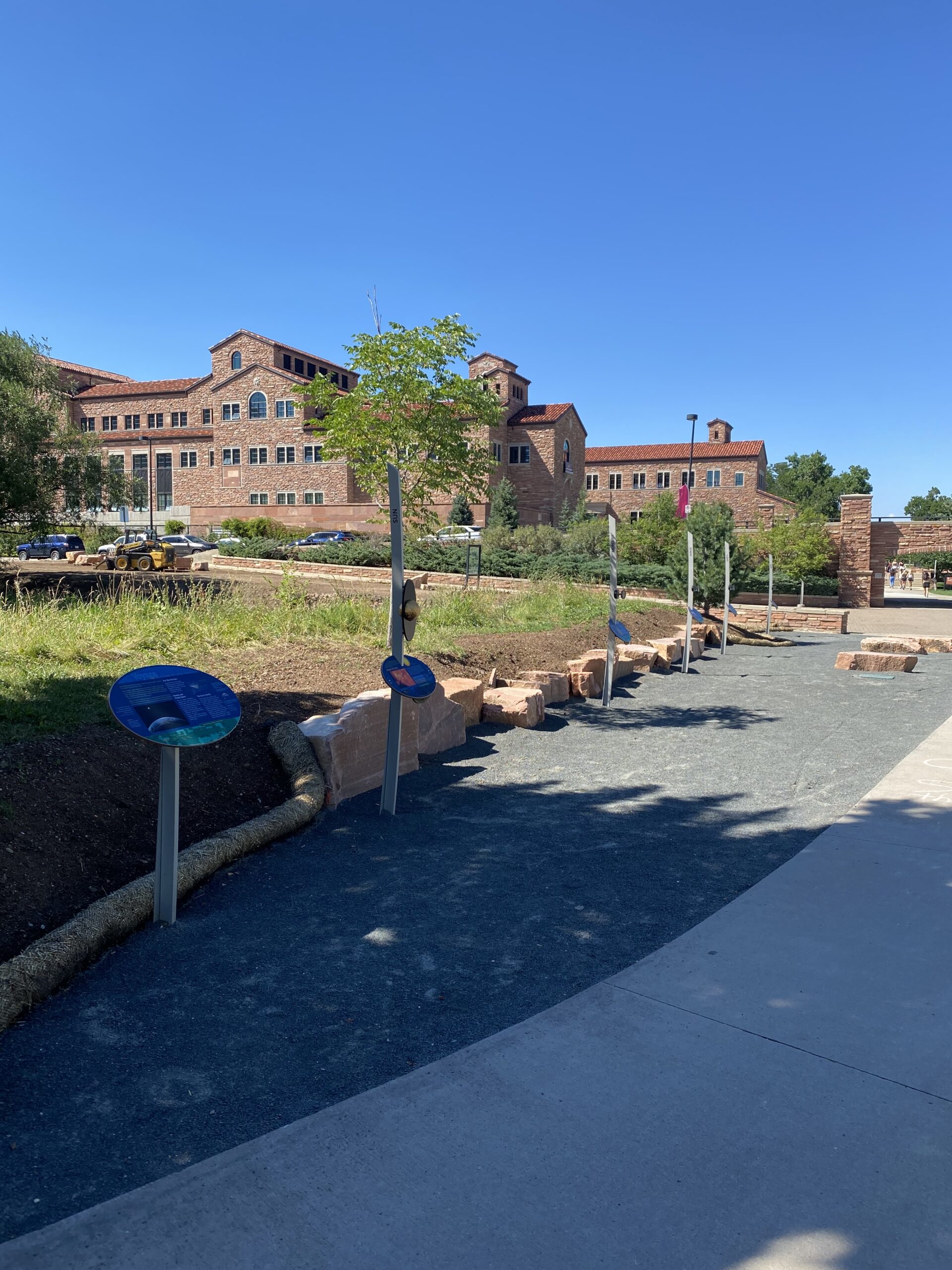
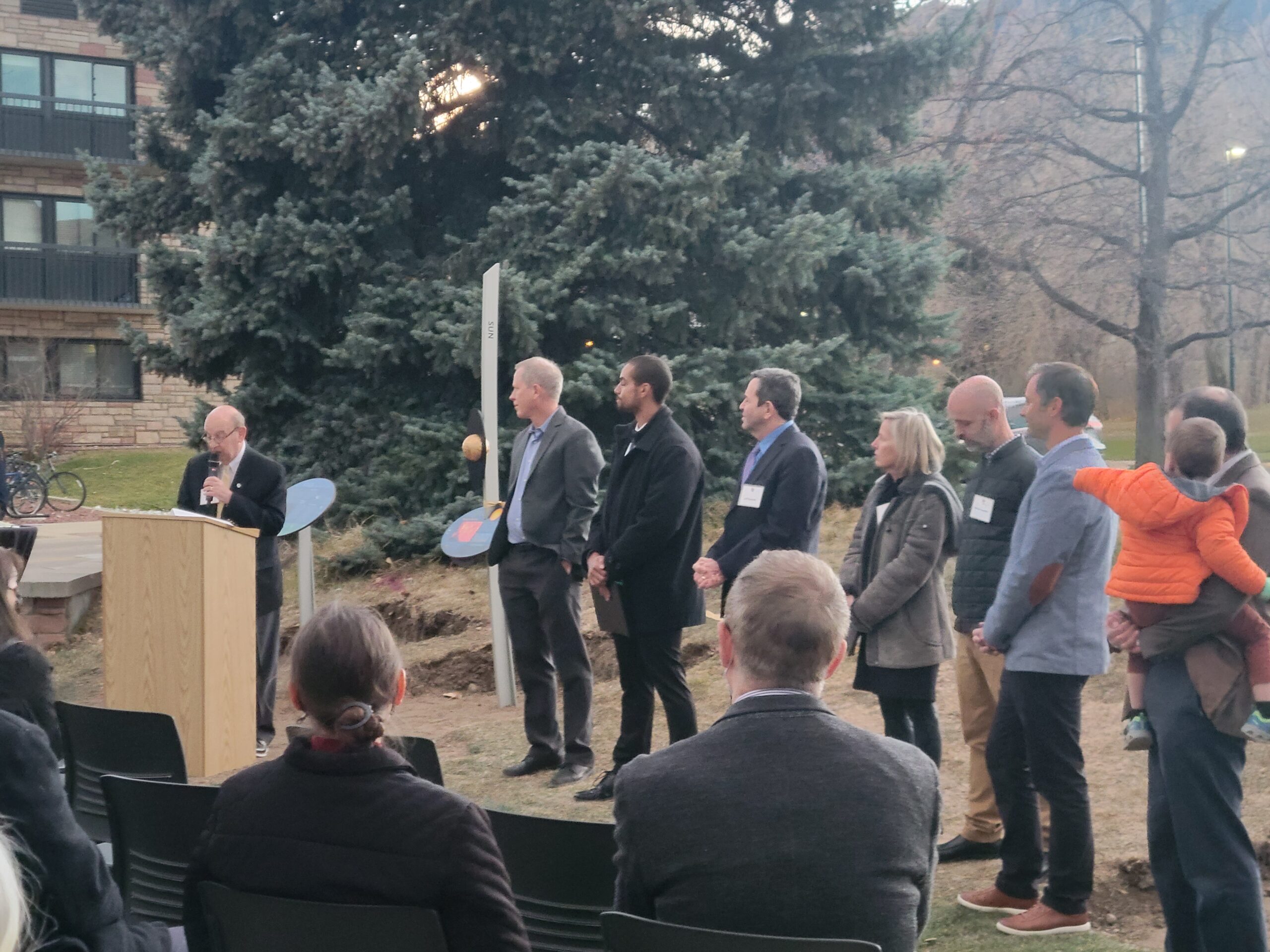

Some interesting facts illustrated in the model
Click here for a Virtual Tour of the Voyage model,
or here for a video tour of the Voyage model in Memphis, TN (use links at left side of page)
The Sun is roughly the size of a grapefruit (14 cm diameter), while the planets range in size from pinheads (Earth is about 1.3 mm in diameter) to marble-size Jupiter.
The inner planets (Mercury, Venus, Earth, Mars) are all located within a couple dozen steps of the sun, with the Earth located 15 meters from the Sun. The outer planets are spread much farther apart. Walking the full length of the model would take about ten minutes, not including stops.
The Colorado model has planets located at their average distances from the Sun, with the exception of dwarf planet Pluto, which is located in between its nearest and average distances, with its position chosen to avoid the need to cross Folsom Street.
Pluto is included in the Colorado/Voyage models, partly because it was still classified a planet when the models originally opened, and also because this illustrates the fact that it’s still out there, no matter how humans choose to classify it.
You can fit the Earth and the entire orbit of the Moon in the palm of your hand — which represents the farthest humans have ever traveled. Of course, we’ve sent robotic explorers much farther, out to Pluto and beyond.
On this same scale, the nearest stars besides the Sun are more than 4,000 kilometers (2,500 miles) away — roughly the distance from Boulder to the Panama Canal (equivalent to the distance across the United States).
